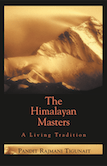Everything is possible with constant and sincere effort.
—Swami RamaThe purpose of life is to know yourself at every level. The obstacles that may arise from the physical level of your being can be prevented by living in a holistic manner: eating a
balanced diet, practicing yogic exercises, regulating the four primitive urges—food, sleep, sex, and self-preservation—and going to bed and waking up on schedule.
Happiness is the creation of the mind.
But after knowing the dynamics of physical well-being and securing it, you come to realize that true happiness does not come from the body: happiness is the creation of the mind. An unhealthy body can create obstacles to achieving peace and happiness, but a healthy body contributes very little to happiness. It is the mind which has to be made healthy, which has to be disciplined and brought under control. Breath is the key to accomplishing this.
A human being is neither body nor mind alone: a human being is also a breathing being. The body and mind are held together with the power of the pranic force, and breath is the major manifestation of that force. As long as people are breathing they are alive, because the breath creates a link between body and mind. The breath works like a customs officer, registering everything that is exported and imported from either side. According to the Upanishads, the breath is like a queen bee. The body and mind with all their organs and faculties follow this queen bee.

The degree of health and physical strength you gain by following a holistic lifestyle can be refined and advanced by practicing pranayama. And when seekers are advanced enough to do this, they have the ability to notice subtler causes of disturbance that arise directly from the mind. This is when they must make a commitment to the inward journey—the practice of meditation.
The stream of life is filled with numberless and mysterious currents and crosscurrents, and after making some initial efforts to meditate and noticing a good degree of improvement, students may experience unconscious memories and habit patterns springing up from the depths of the unconscious mind. At this juncture, they cannot escape—nor is there a need to escape—from their own unconscious material, their samskaras. Standing on the firm ground of vairagya, non-attachment, and with the help of the systematic practice of meditation and contemplation, they can dive deep within, explore the subtle causes of habit patterns, previously unknown to the conscious mind, and return to the safety of that firm ground. In this way they attain freedom from their samskaras once and for all. The mind is free from all conscious and unconscious preoccupations. It is like a clear mirror. And in this mirror, atman, the inner self, is reflected spontaneously.

The knowers of truth, those who have completed the entire journey from beginning to end, divide life into three categories: mortal, semi-mortal, and immortal. The body, breath, and conscious mind are the mortal part of the human being. At the other end of the spectrum is the soul, the inner self, which is immortal. In between is the unconscious mind, which is semi-mortal or semi-immortal. The mortal part of our being goes through the constant change of death, decay, and destruction. It is born, and one day it dies. Whatever actions we perform through this mortal part of ourselves—whether physical, verbal, or mental—create impressions in the unconscious mind. They are stored there in the form of samskaras and motivate our mind, senses, and body to undertake more actions.
Once you attain freedom, you realize that you are pure atman.
This vicious cycle never ends unless we apply the techniques of spiritual discipline. This is because at the time of death, when the body and conscious mind fall apart, human beings are still alive, dwelling in the unconscious mind. And there the samskaras of unfulfilled desires force the unconscious to beg nature to provide them with a new body. And thus human beings go through the process of rebirth.
Once you attain freedom from the samskaras stored in the unconscious, semi-mortal part of your being, however, you realize that you are pure atman, the eternal self, which is not subject to either birth or death. Such a realized person is “immortal.”
Source: “Swami Rama of the Himalayas” in The Himalayan Masters: A Living Tradition by Pandit Rajmani Tigunait, PhD

